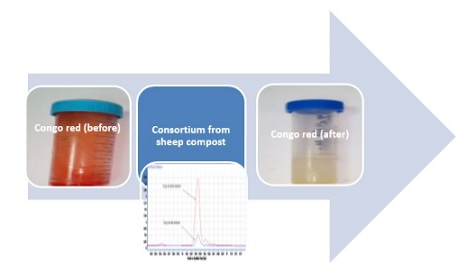Document Type : ORIGINAL RESEARCH ARTICLE
Authors
1 Regional Center for Food and Feed, Agricultural Research Center, Cairo, Egypt
2 Microbiology Department, Faculty of Agriculture, Cairo University, Cairo, Egypt
3 Agricultural Genetic Engineering Research Institute, Agricultural Research Center, Cairo, Egypt
Abstract
Congo red is a synthetic azo-dye dye with many industrial applications. The effluents containing azo dyes are causing several environmental hazards and thus should be treated prior to their discharge. The present work investigates the possible use of a novel microbial consortium from sheep compost for the decolorization of Congo red dye. The effect of different parameters including contact time, dye concentration and inoculum concentration on dye decolorization were investigated. The kinetic of dye decolorization was also assessed and the biodegradation of the dye was confirmed by different techniques. The results showed that the microbial consortium decolorized about 98% of Congo red (500 mg/L) after 24h. The efficiency of the decolorization decreased from 95% to 62% when the dye concentration increased from 100 to 500mg/L. Also, it was noticed that 75% of Congo red (25 mg/L) was decolorized at an inoculum rate of 2.5%. The kinetic results suggested that the decolorization of Congo red by the studied consortium follows the first order kinetic model. Also the maximum substrate consumption rate (Vmax) according to Michaelis- Menten model was found to be 19.30 mg/h/L and the decolorization rate constant (Km) was 116.93 mg/L. The biodegradation of Congo red was further confirmed by HPLC and GC-Ms analysis which revealed the presence of some spectral differences between the untreated dye sample and the treated one. In conclusion, the results of the present work suggest that microbial consortium from sheep compost could have potential application for bioremediation of industrial effluents containing Congo red dye.
Graphical Abstract
Highlights
- Sheep farm compost was used as novel source of microbial consortium
- Microbial consortium successfully decolorized Congo red solutions
- Removal efficiency of dye reached 98% after 24 hours
- Small amount of consortium (2.5%) decolorized more than 75% of Congo red.
Keywords



Letters to Editor
[1] Letters that include statements of statistics, facts, research, or theories should include appropriate references, although more than three are discouraged.
[2] Letters that are personal attacks on an author rather than thoughtful criticism of the author’s ideas will not be considered for publication.
[3] Letters can be no more than 300 words in length.
[4] Letter writers should include a statement at the beginning of the letter stating that it is being submitted either for publication or not.
[5] Anonymous letters will not be considered.
[6] Letter writers must include their city and state of residence or work.
[7] Letters will be edited for clarity and length.
Send comment about this article